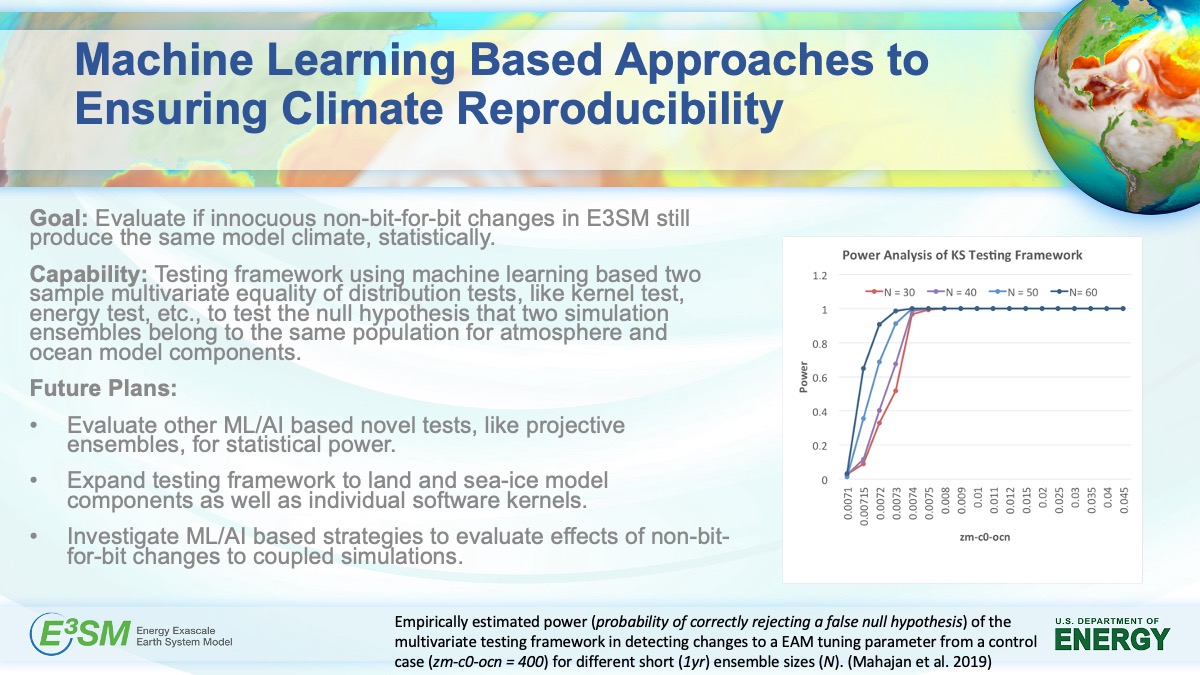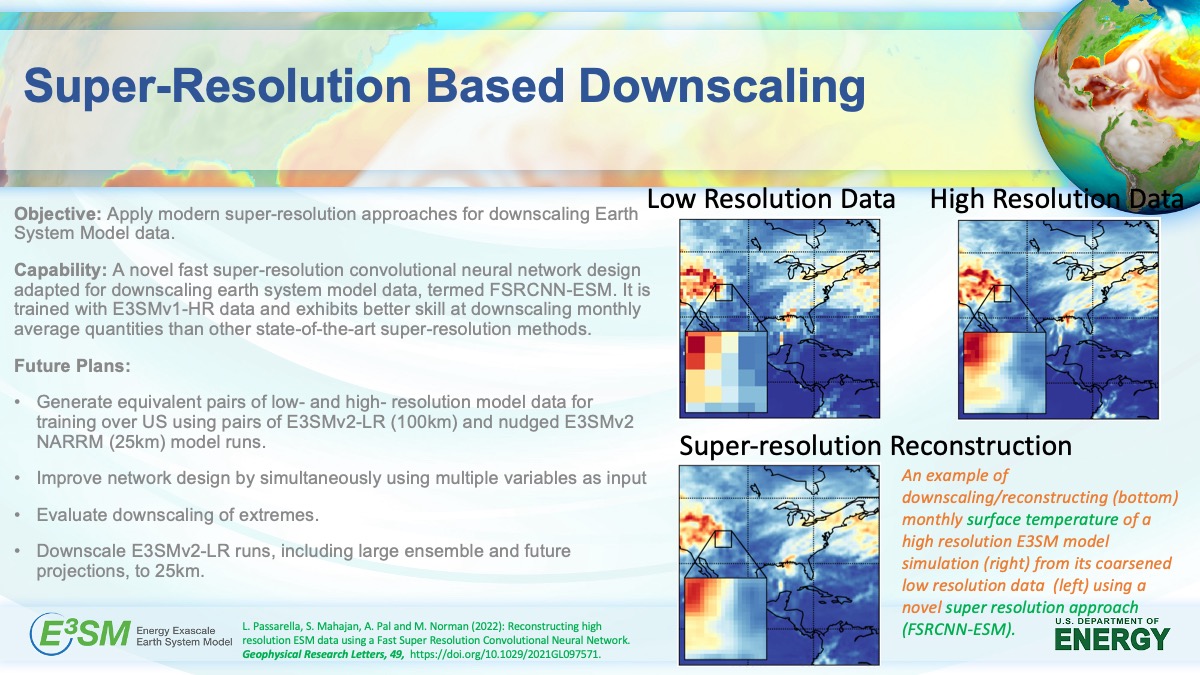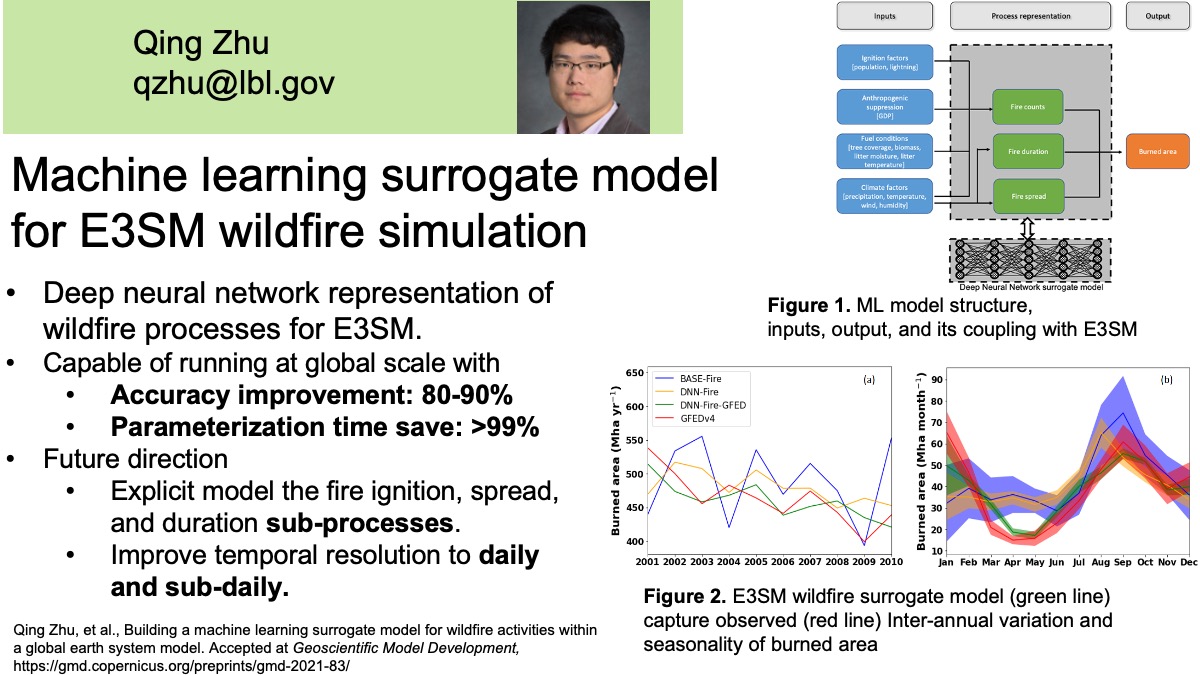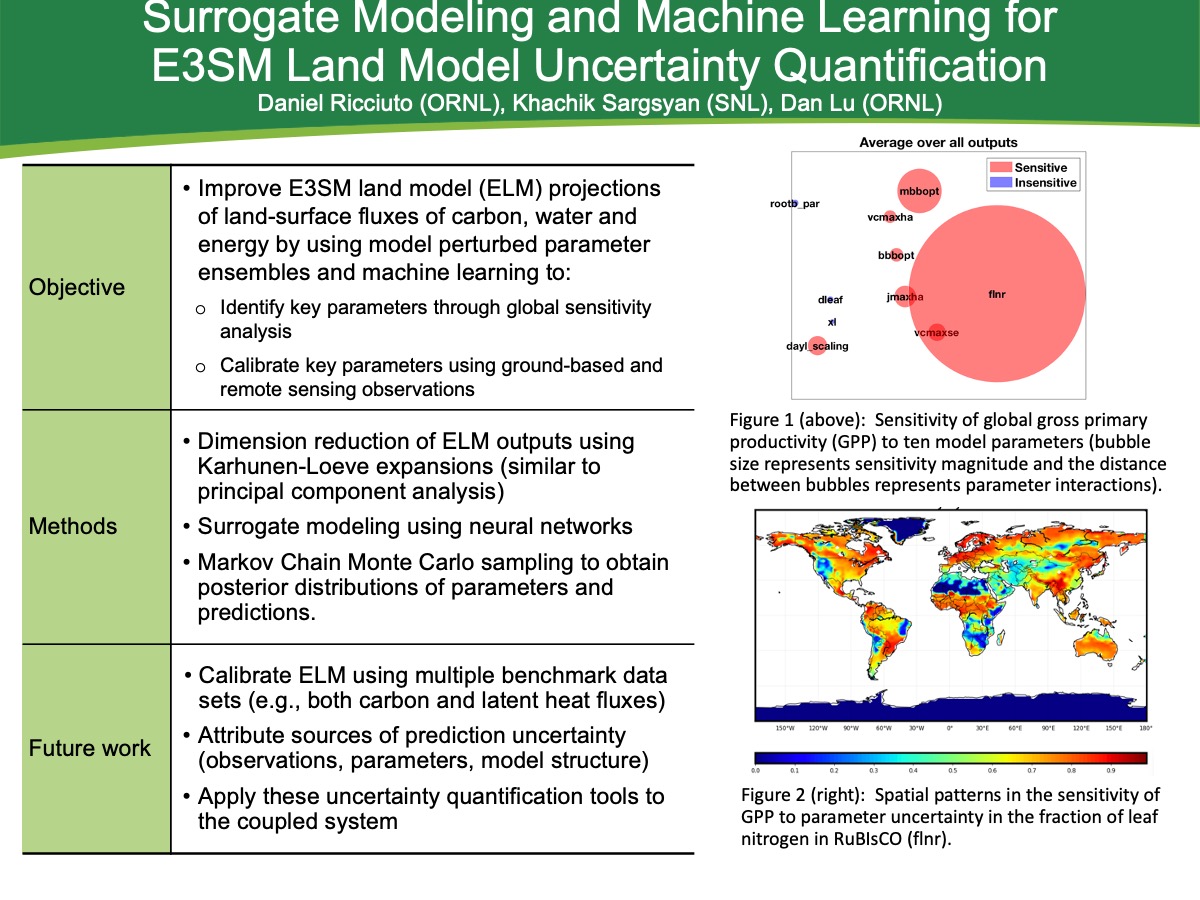Ongoing ML/AI Work Towards E3SM
 Since its inception in 2014, the E3SM project’s ten-year vision was to deliver a state-of-the-science climate model running on DOE Leadership Exascale-class supercomputers for the DOE mission. Pushing past Exascale will require ever-more disruptive approaches such as edge computing, machine learning (ML), and next-generation artificial intelligence (AI) accelerating the fusion of observations and measurements with computing. By continuously integrating advanced technologies and climate science to deliver capabilities for multi-resolution modeling of the Earth-human system, the 2032 E3SM model will be at the center of a connected scientific ecosystem for understanding and modeling the Earth system.
Since its inception in 2014, the E3SM project’s ten-year vision was to deliver a state-of-the-science climate model running on DOE Leadership Exascale-class supercomputers for the DOE mission. Pushing past Exascale will require ever-more disruptive approaches such as edge computing, machine learning (ML), and next-generation artificial intelligence (AI) accelerating the fusion of observations and measurements with computing. By continuously integrating advanced technologies and climate science to deliver capabilities for multi-resolution modeling of the Earth-human system, the 2032 E3SM model will be at the center of a connected scientific ecosystem for understanding and modeling the Earth system.
The E3SM project and its ecosystem projects are already working towards the next-generation ML/AI approach in multiple areas. Below are some selected highlights of such developments.
Machine Learning-Based Approaches to Ensuring Climate Reproducibility
Salil Mahajan’s (E3SM project) work on reproducibility (Fig. 1) aims to statistically evaluate if innocuous non-bit-for-bit changes in E3SM still produce the same model climate. It enables the development of a testing framework using machine learning-based two samples multivariate equality of distribution tests, like kernel test, energy test, etc., to test the null hypothesis that two simulation ensembles belong to the same population for atmosphere and ocean model components.
Super-Resolution Based Downscaling
In another development, Salil Mahajan (E3SM project) applies a novel fast super-resolution convolutional neural network design adapted for downscaling earth system model data, termed FSRCNN-ESM (Fig. 2). It is trained with high-resolution E3SMv1-HR data and exhibits better skill at downscaling monthly average quantities than other state-of-the-art super-resolution methods.
Machine Learning Surrogate Model for E3SM Wildfire Simulation
Qing Zhu (E3SM project) developed a Deep Neural Network (DNN) representation of wildfire processes for E3SM (Fig. 3). It is capable of running at a global scale with an accuracy improvement of 80-90% and with parameterization time save of more than 99%. The DNN model first surrogates wildfire related processes of the physical fire model with E3SM simulated synthetic data. Thus the DNN model could reproduce the physical behavior of wildfire. Then, the DNN model is fine-tuned towards Global Fire Emissions Database (GFED) burned area, which significantly improves the performance of the DNN fire model at global scale in terms of wildfire seasonality, inter-annual variability, and spatial distributions.
Surrogate Modeling and Machine Learning for E3SM Land Model Uncertainty Quantification
The goal of the work by Daniel Ricciuto, Khachik Sargsyan and Dan Lu’s (E3SM project) is to improve E3SM land model (ELM) projections of land-surface fluxes of carbon, water, and energy by using model perturbed parameter ensembles and surrogate modeling using neural networks (Fig. 4) to identify key parameters through global sensitivity analysis and to calibrate key parameters using ground-based and remote sensing observations.
E3SM Autotuning
Benjamin Wagman, Kenny Chowdhary, Andy Salinger (E3SM project) work toward an automated E3SMv2 parameter sampling and ensemble generation using DAKOTA and tesuract, a new Python library for ML-based emulators. Their approach uses surrogate construction for E3SMv2 spatial fields using machine learning and reduced-order modeling enabling deterministic and Bayesian calibration for 5 uncertain E3SMv2 parameters.
MuSiKAL: Multiphysics Simulations and Knowledge discovery through AI/ML technologies
Dawson, Kaiser, Westerink, and Leung (funded by ASCR) are developing a digital twin platform capable of integrating diverse data resources, configuring multiscale model simulations, performing SciML-accelerated predictions, and transfer learning, and provide a team environment for end-users to engage in collaborations (Fig. 6). As the first demonstration, they will develop a digital twin system for coastal rainfall, wind predictions, with impact on inundation and flood modeling, and risk mitigation in the U.S. Gulf Coast. E3SM will serve as the underpinning “physics-based” model, to be evaluated for coastal applications.
Quantification of Extreme Weather Events and Their Future Changes Using Physics-Informed DeepONet Modeling and Functional Priors
Sapsis, Karniadakis, and Leung (funded by DARPA) use ML to improve climate simulations (Fig. 7) by correcting errors in the representation of physical processes such as convection and clouds (a major sources of climate model biases). Climate simulations can be bias-corrected using nudging, with the nudging tendencies acting as an ML parameterization of the column physics, combined with the existing physics parameterizations for hybrid modeling. Physics-informed DeepONet is used in machine learning of the nudging tendencies to improve low-resolution E3SM simulations. The latter, combined with storm-resolving simulations, will be used to project future changes in extreme weather events.
Improving Aerosol Radiative Effects: Emulating Aerosol Optics Using Random Neural Network
Andrew Geiss and Po-Lun Ma (EAGLES project) aim to improve the representation of aerosol optics in E3SM and by building ML emulators based on explicit Mie scattering calculations (Fig. 8). They used random wirings to find a network architecture that is computationally inexpensive and accurate. This approach enables accounting for the shell-core lensing effects in E3SM.
Improving aerosol’s cloud albedo effect: Emulating aerosol activation using deep neural network

Improving aerosol’s cloud lifetime effects: Emulating warm rain initiation using deep neural network
Sam Silva, Po-Lun Ma, Mike Pritchard, Sungduk Yu, and Balwinder Singh (EAGLES project) improve aerosol activation in E3SM by correcting the E3SM bias introduced by the original parameterization without adding computational cost (Fig. 9). They developed ML emulators of different architectures based on explicit cloud parcel model results and train them on big data (over 100M samples) and identified the optimal emulator to implement in E3SM. With the emulator, E3SM produces stable and more realistic global simulation.
Improving aerosol’s cloud lifetime effects: Emulating warm rain initiation using deep neural network

Improving aerosol’s cloud lifetime effects: Emulating warm rain initiation using deep neural network
Po-Lun Ma, Jacob Shpund, Chris Jones, Adam Varble, Colleen Kaul, Kyle Pressel, Mike Pritchard, Sungduk Yu, Jamin Rader, Sam Silvar, Jiwen Fan, and Balwinder Singh (EAGLES project) are developing a representation of warm rain initiation (i.e., autoconversion) suitable for E3SM global simulations (Fig. 10). They built ML emulators based on explicit collision-coalescence calculations and environmental conditions and train them on big data covering a wide range of aerosol, cloud, meteorological conditions. They also incorporate physical constraints in the emulator to better represent the multi-scale physics, evolution of the cloud droplet size distribution (DSD), and environmental conditions.
Machine learning and artificial intelligence techniques are becoming ever more ubiquitous, useful and powerful. The E3SM project together with the ecosystem projects are well positioned to take full advantage of those new, advanced technologies.
This article is a part of the E3SM “Floating Points” Newsletter, to read the full Newsletter check:










